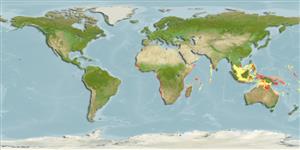Common names from other countries
>
Eupercaria/misc (Various families in series Eupercaria) >
Sciaenidae (Drums or croakers)
Etymology: Atractoscion: Greek, atraktos, arrow + Greek, skion, skiaina = barbel, red mullet (Ref. 45335).
More on author: Cuvier.
Environment: milieu / climate zone / depth range / distribution range
Ökologie
seewasser benthopelagisch; tiefenbereich 15 - 200 m (Ref. 3593), usually 100 - 200 m (Ref. 3593). Tropical; 14°N - 28°S
Western Indian Ocean: off Mozambique and South Africa.
Length at first maturity / Size / Gewicht / Alter
Maturity: Lm ?, range 65 - ? cm
Max length : 130 cm TL Männchen/unbestimmt; (Ref. 4373); common length : 90.0 cm SL Männchen/unbestimmt; (Ref. 9772); max. veröff. Gewicht: 25.0 kg (Ref. 4373)
Rückenflossenstacheln (insgesamt) : 10 - 11; Rückenflossenweichstrahlen (insgesamt) : 25 - 32; Afterflossenstacheln: 2; Afterflossenweichstrahlen: 9 - 10. Body silvery (Ref. 4373).
Found in coastal waters, over sand muddy bottom. Juveniles enter estuaries. Adults feed on pelagic fishes at night. Often caught with Umbrina canariensis. Feeds on pelagic fish such as mackerel and horse mackerel (Ref. 36731). Marketed fresh, flesh highly esteemed (Ref. 9772).
Life cycle and mating behavior
Maturities | Fortpflanzung | Spawnings | Egg(s) | Fecundities | Larven
Chao, L.N. and E. Trewavas, 1990. Sciaenidae. p. 813-826. In J.C. Quero, J.C. Hureau, C. Karrer, A. Post and L. Saldanha (eds.) Check-list of the fishes the eastern tropical Atlantic (CLOFETA). JNICT, Lisbon; SEI, Paris; and UNESCO, Paris. Vol. 2. (Ref. 3593)
IUCN Rote Liste Status (Ref. 130435)
CITES (Ref. 128078)
Not Evaluated
Bedrohung für Menschen
Harmless
Nutzung durch Menschen
Fischereien: kommerziell; Sportfisch: ja
Tools
Zusatzinformationen
Download XML
Internet Quellen
Estimates based on models
Preferred temperature (Ref.
115969): 14 - 26.5, mean 18.7 (based on 131 cells).
Phylogenetic diversity index (Ref.
82804): PD
50 = 0.5312 [Uniqueness, from 0.5 = low to 2.0 = high].
Bayesian length-weight: a=0.00851 (0.00413 - 0.01752), b=3.08 (2.91 - 3.25), in cm Total Length, based on LWR estimates for this (Sub)family-body shape (Ref.
93245).
Trophic level (Ref.
69278): 4.5 ±0.80 se; based on food items.
Widerstandsfähigkeit (Ref.
120179): niedrig, Verdopplung der Population dauert 4,5 - 14 Jahre. (K=0.27; tm=5).
Fishing Vulnerability (Ref.
59153): Moderate to high vulnerability (51 of 100).
Climate Vulnerability (Ref.
125649): Very high vulnerability (83 of 100).
